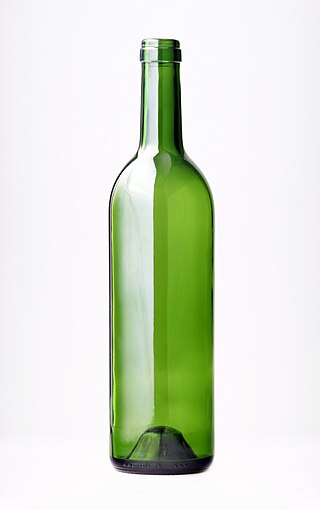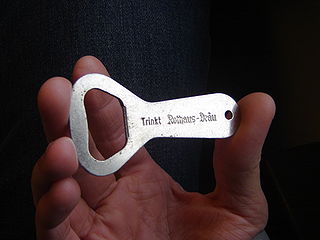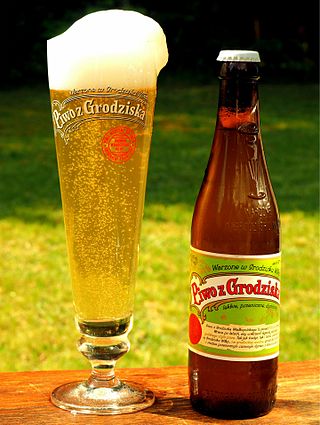
A bottle is a narrow-necked container made of an impermeable material in various shapes and sizes that stores and transports liquids. Its mouth, at the bottling line, can be sealed with an internal stopper, an external bottle cap, a closure, or induction sealing.
A screw cap or closure is a common type of closure for bottles, jars, and tubes.

A drink can is a metal container with a polymer interior designed to hold a fixed portion of liquid such as carbonated soft drinks, alcoholic drinks, fruit juices, teas, herbal teas, energy drinks, etc. Drink cans exteriors are made of aluminum or tin-plated steel and the interiors coated with an epoxy resin or polymer. Worldwide production for all drink cans is approximately 370 billion cans per year.

A bottle cap or bottle top is a common closure for the top opening of a bottle. A cap is sometimes colorfully decorated with the logo of the brand of contents. Metal caps with plastic backing are used for glass bottles, sometimes wrapped in decorative foil. Metal caps are usually either steel or aluminum, and of the crown cork type. Flip-top caps preceded such caps.

Koninklijke Grolsch N.V., known simply as Grolsch, is a Dutch brewery founded in 1615 by Willem Neerfeldt in Groenlo. In 1895, the de Groen family bought the brewery. They had started their own brewery in Enschede in the early 19th century and held a significant stake until 2007. Today the main brewery is in Enschede.

Bottling lines are production lines that fill a liquid product, often a beverage, into bottles on a large scale. Many prepared foods are also bottled, such as sauces, syrups, marinades, oils and vinegars.

A beer bottle is a bottle designed as a container for beer. Such designs vary greatly in size and shape, but the glass commonly is brown or green to reduce spoilage from light, especially ultraviolet.

A bottle opener is a device that enables the removal of metal bottle caps from glass bottles. More generally, it might be thought to include corkscrews used to remove cork or plastic stoppers from wine bottles.

A closure is a device used to close or seal a container such as a bottle, jug, jar, tube, or can. A closure may be a cap, cover, lid, plug, liner, or the like. The part of the container to which the closure is applied is called the finish.

A keg is a small cask used for storing liquids. Wooden kegs made by a cooper were used to transport nails, gunpowder, and a variety of liquids. Nowadays a keg is normally constructed of stainless steel, although aluminium can be used if it is coated with plastic on the inside. It is commonly used to store, transport, and serve beer. Other alcoholic or non-alcoholic drinks, carbonated or non-carbonated, may be housed in a keg as well. Carbonated drinks are generally kept under pressure in order to maintain carbon dioxide in solution, preventing the beverage from becoming flat.
Crown Holdings, Inc., formerly Crown Cork & Seal Company, is an American company that makes metal beverage and food cans, metal aerosol containers, metal closures and specialty packing. Founded in 1892, it is headquartered in Tampa, Florida. As of their annual report for 2020, Crown employs 33,264 people at 192 plants in 39 countries. It claims to manufacture one out of every five beverage cans used in the world, and one out of every three food cans used in North America and Europe. The company is ranked No. 286 in the Fortune 500 list for 2022 and is number one in the packaging and container industry for the same list.

Common uses for bottles made from glass include food condiments, soda, liquor, cosmetics, pickling and preservatives; they are occasionally also notably used for the informal distribution of notes. A glass bottle can vary in size considerably, but are most commonly found in sizes ranging between about 200 millilitres and 1.5 litres.

A church key or churchkey is a North American term for various kinds of bottle openers and can openers.

The Beer Can Museum, located in East Taunton, Massachusetts, is a collection of more than 5,000 different beer cans, along with beer can folk art and crafts, beer can clothing, beer can telephones and radios, and a beer can and breweriana related library. In November 2013, it was included in Travel & Leisure's list of 'America's Strangest Museums.'

Induction sealing is the process of bonding thermoplastic materials by induction heating. This involves controlled heating an electrically conducting object by electromagnetic induction, through heat generated in the object by eddy currents.

Beverage can printing refers to the art and practice of applying an image to a metal beverage can, to advertise its contents.

Grodziskie is a historical beer style from Poland made from oak-smoked wheat malt with a clear, light golden color, high carbonation, low alcohol content, low to moderate levels of hop bitterness, and a strong smoke flavor and aroma. The taste is light and crisp, with primary flavors coming from the smoked malt, the high mineral content of the water, and the strain of yeast used to ferment it. It was nicknamed "Polish Champagne" because of its high carbonation levels and valued as a high-quality beer for special occasions.

A flip-top, swing-top, lightning toggle, or Quillfeldt stopper is a type of bail closure frequently used for bottles containing carbonated beverages, such as beer or mineral water. The mouth of the bottle is sealed by a stopper, usually made of porcelain or plastic, fitted with a rubber gasket and held in place by a permanently attached wire bail. The bottle can be opened and resealed repeatedly without the use of a bottle opener, with the wires acting in the same way as a latch clamp. The flip-top was the dominant method of sealing beer and mineral water bottles prior to the invention of the crown cork.

A growler (US) is a glass, ceramic, or stainless steel bottle used to transport draft beer. They are commonly sold at breweries and brewpubs as a means to sell take-out craft beer. Rarely, beers are bottled in growlers for retail sale. The significant growth of craft breweries and the growing popularity of home brewing has also led to an emerging market for the sale of collectible growlers. Some U.S. grocery stores, convenience stores, bars and restaurants have growler filling stations.

















